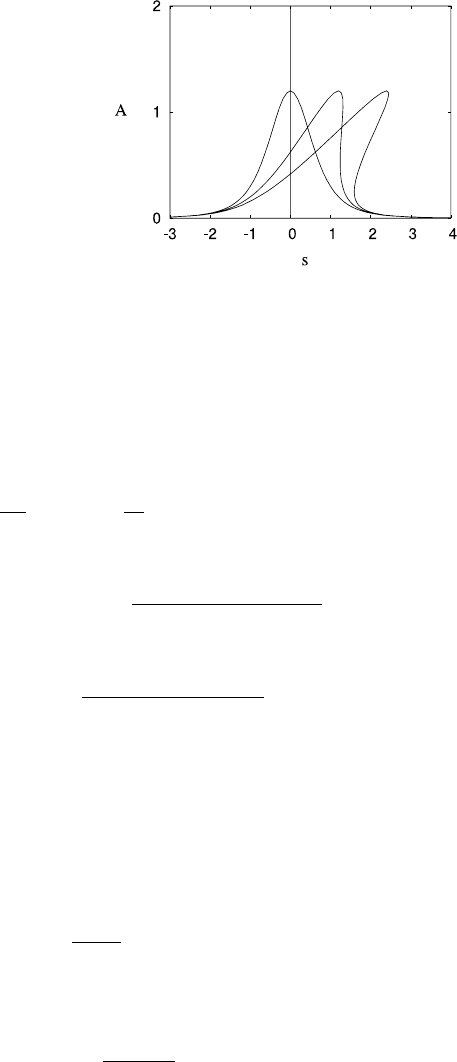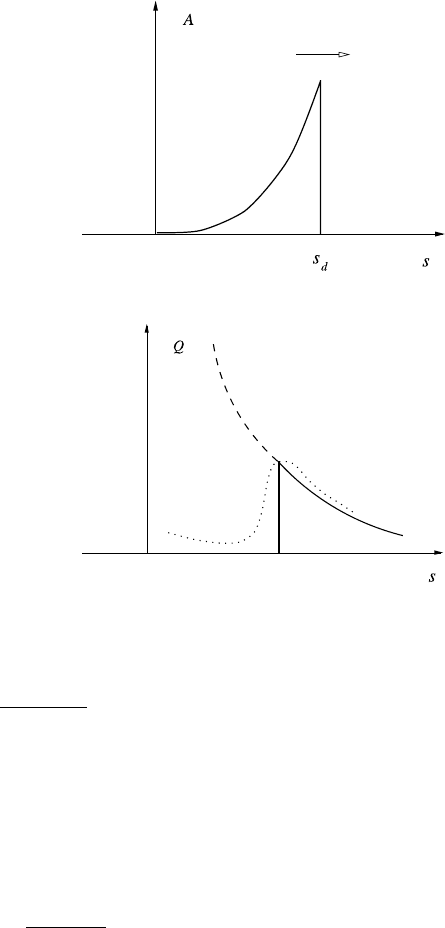Fowler A. Mathematical Geoscience
Подождите немного. Документ загружается.


220 3 Oceans and Atmospheres
where
∇
2
=
∂
2
∂φ
2
+
∂
2
∂ν
2
,
ν =ln
1 +tan
1
2
λ
1 −tan
1
2
λ
,
and φ and λ are longitude and latitude angles.
Show that if solutions are sought in a narrow canal at latitude λ with ends
at φ =±
L
2
, and boundary conditions of no flow through the boundaries, i.e.,
∂
∂n
(η −χ) = 0,
then
η =
cos
2
δ cos
2
λ
1 −S
2
cos
2
λ
[A cos 2St +B sin 2St],
where
A =cos2φ −
S cos λ sin L cos(2Sφ cos λ)
sin(LS cos λ)
,
B =−sin2φ +
S cos λ cos L sin(2Sφ cos λ)
cos(LS cos λ)
.
3.12 A tsunami is modelled by the wave equation
∂
2
η
∂t
2
=
1
r
∂
∂r
r
∂η
∂r
,
subject to the conditions that
η =0att =0,r=0,
η →0asr →∞,
2π
∞
0
rηdr ≡V.
Show that a similarity solution of this problem can be found in which
η =
1
t
2
f(ξ), ξ =
r
t
,
and that f satisfies the equation
ξ
3
f
=(ξf
)
;

3.13 Exercises 221
write down the boundary condition and integral constraint for f .
Show that there exists a solution of the form
f =
A
(1 −ξ
2
)
3/2
1
ξ
(1 −s
2
)
1/2
ds
s
, 0 <s<1,
f =
A
(ξ
2
−1)
3/2
ξ
1
(s
2
−1)
1/2
ds
s
,s>1,
if we assume f is finite at ξ =1.
Show that this solution is continuous at ξ =1 but has discontinuous deriva-
tive there. Show also that the solution in ξ>1 cannot satisfy the integral
constraint on f .
Suppose instead that the solution above in ξ<1 is correct, but f = 0in
ξ>1. Use the integral constraint to show that
A =
V
2π[1 −ln 2]
,
and show that the wave front at r =t is of height
1
3
A.
Does this solution make sense? Is the position of the wave front uniquely
defined? Show that f ∼−A ln ξ as ξ → 0, and deduce (explaining why) that
no solution of this type is appropriate.
3.13 The stream function ψ of the ocean circulation satisfies the equation
βψ
x
=−1 +E
H
∇
4
ψ
in the closed domain B, with boundary conditions
ψ =
∂ψ
∂n
=0on∂B.
If B is the box 0 <x<1, 0 <y<1, find a suitable scaling for the bound-
ary layer near y = 0, and hence show that in terms of the rescaled boundary
layer coordinates x and Y , ψ satisfies the boundary layer equation
βψ
x
=−1 +ψ
YYYY
,
together with the boundary conditions
ψ =ψ
Y
=0onY =0,ψ→∞ as Y →∞,
and the ‘initial’ condition
ψ =0onx =1.
Show that a similarity solution for this equation exists in the form
ψ =
1 −x
β
1 −f(η)
,η=Y
β
1 −x
1/4
,

222 3 Oceans and Atmospheres
and that f satisfies the equation
f
iv
−ηf
+4f =0,
with
f(0) =1,f
(0) =0,f(∞) =0.
Find four independent possible asymptotic behaviours for f as η →∞,
and show that only two tend to zero. Hence deduce that the given boundary
conditions should be sufficient to determine the solution uniquely.
3.14 The normalised amplitude of a tsunami wave satisfies the equation
φ
tt
=φ
rr
+
φ
4r
2
.
Seek solutions valid for large r and t by changing variables to ξ = r −t and
τ = t, and show that an asymptotic solution for large t can be found with the
assumption that
φ ∼
∞
0
φ
n
(ξ)
t
n
.
Show that φ
1
=
1
8
φ
0
, φ
2
=−
1
8
ξφ
0
−
7
16
φ
1
, and hence find the expansion
for φ correct to terms of O(
1
t
2
), assuming that φ
0
is known.
Chapter 4
River Flow
Much of the environment consists of fluids, and much of this book is therefore
concerned with fluid mechanics. Oceans and atmosphere consist of fluids in large
scale motion, and even later, when we deal with more esoteric subjects: the flow of
glaciers, convection in the Earth’s mantle, it is within the context of fluid mechanics
that we formulate relevant models. This chapter concerns one of the most obvious
common examples of a fluid in motion, that of the mechanics of rivers.
Fluid mechanics in the environment is, however, altogether different to the sub-
ject we study in an undergraduate course on viscous flow, and the principal reason
for this is that for most of the common environmental fluid flows with which we
are familiar, the flow is turbulent. (Where it is not, for example in glacier flow,
other physical complications obtrude.) As a consequence, the models which we use
to describe the flow are different to (and in fact, simpler than) the Navier–Stokes
equations.
4.1 The Hydrological Cycle
Rainwater which falls in a catchment area of a particular river basin makes its way
back to the ocean (or sometimes to an inland lake) by seepage into the ground,
and then through groundwater flow to outlet streams and rivers. In severe storm
conditions, or where the soil is relatively impermeable, the rainfall intensity may
exceed the soil infiltration capacity, and then direct runoff to discharge streams can
occur as overland flow. Depending on local topography, soil cover, vegetation, one
or other transport process may be the norm. Overland flow can also occur if the soil
becomes saturated. The hydrological cycle is completed when the water, now back
in the ocean, is evaporated by solar radiation, forming atmospheric clouds which are
the instrument of precipitation.
River flow itself occurs on river beds that are typically quasi-one-dimensional,
sinuous channels with variable and rough cross section. Moreover, if the channel
A. Fowler, Mathematical Geoscience, Interdisciplinary Applied Mathematics 36,
DOI 10.1007/978-0-85729-721-1_4, © Springer-Verlag London Limited 2011
223

224 4 River Flow
discharge is Q (m
3
s
−1
), and the wetted perimeter length of the cross section is l
(m), then an appropriate Reynolds number for the flow is
Re =
Q
νl
, (4.1)
where ν =μ/ρ is the kinematic viscosity (and μ is the dynamic viscosity). If l =
20 m, ν =10
−6
m
2
s
−1
, Q =10 m
3
s
−1
, then Re ∼0.5 ×10
6
. Inevitably, river flow
is turbulent for all but the smallest rivulets. A different measure of the Reynolds
number is
Re =
uh
ν
, (4.2)
where u is mean velocity and h is mean depth. In a wide channel, we find that the
width is approximately l, so that Q ≈ ulh, and this gives the same definition as
(4.1). Thus, to model river flow, and to explain the response of river discharge to
storm conditions, as measured on flood hydrographs, for instance, one must model
a flow which is essentially turbulent, and which exists in a rough, irregular channel.
The classical way in which this is done is by applying a time average to the
Navier–Stokes equations, which leads to Reynolds’ equation, which is essentially
like the Navier–Stokes equation, but with the stress tensor being augmented by a
Reynolds stress tensor. The procedure is described in Appendix B.
For a flow u =(u,v,w) which is locally unidirectional on average, such as that
in a river, we may take the mean velocity
¯
u =( ¯u, 0, 0), and then the x component
of the momentum equation becomes
ρ
∂
∂z
(
u
w
) ≈−
∂ ¯p
∂x
+μ
∂
2
¯u
∂z
2
, (4.3)
because in a shallow flow, the other Reynolds stress terms are smaller. Integration
over the depth shows that the resistance to motion is provided by the wall stress τ ,
and this is
τ =μ
∂ ¯u
∂z
+{−ρ
u
w
}, (4.4)
evaluated at the wetted perimeter of the flow. Strictly, the Reynolds stress vanishes
at the boundary (because the fluid velocity is zero there), and the molecular stress
changes rapidly to compensate, in a very thin laminar wall layer. Normally one
evaluates (4.4) just outside this layer, close to but not at the boundary, where the
molecular stress is negligible and the Reynolds stress is parameterised in some way.
A common choice is to use a friction factor, thus
τ =fρ ¯u
2
, (4.5)
where the dimensionless number f (called the friction factor) is found to depend
rather weakly on the Reynolds number.
1
A crude but effective assumption is simply
that f is constant, with a typical value for f of 0.01.
1
More precisely, the stress should be τ = fρ|¯u|¯u, since the friction acts in the opposite direction
to the flow. For unidirectional flows, this reduces to (4.5). Later (in Sect. 4.5.3), we will have need
for this more precise formula.

4.2 Chézy’s and Manning’s Laws 225
4.2 Chézy’s and Manning’s Laws
Our starting point is that the flow is essentially one-dimensional: or at least, we focus
on this aspect of it. As well as the cross-sectional area (of the flow) A and discharge
Q, we introduce a longitudinal, curvilinear distance coordinate s, and we assume
that the river axis changes direction slowly with s. Then conservation of mass is, in
its simplest form,
∂A
∂t
+
∂Q
∂s
=M. (4.6)
This source term M represents the supply to the river due to infiltration seepage and
overland flow from the catchment.
(4.6) must be supplemented by an equation for Q as a function of A, and this
arises through consideration of momentum conservation. There are three levels at
which one may do this: by exact specification, as in the Navier–Stokes momentum
equation; by ignoring inertia and averaging, as in Darcy’s law; and most simply, by
ignoring inertia and applying a force balance using a semi-empirical friction factor.
We begin by opting for this last choice, which should apply for sufficiently ‘slow’
(in some sense) flow. Later we will consider more complicated models.
We have already defined the Reynolds number Re in terms of Q and A, or equiv-
alently a mean velocity u =Q/A and a channel depth d ∼A
1/2
. ‘Slow’ here means
asmallFroude number, defined by
Fr =
u
(gd)
1/2
=
Q
g
1/2
A
5/4
. (4.7)
If Fr < 1, the flow is tranquil;ifFr > 1, it is rapid. Gravity is of relevance, since
the flow is ultimately due to gravity.
Now let l be the wetted perimeter of a cross section, and let τ be the mean shear
stress exerted at the bed (longitudinally) by the flow. If the downstream angle of
slope is α, then a force balance gives
lτ =ρgAsin α, (4.8)
where ρ is density. For turbulent flow, the shear stress is given by the friction law
τ =fρu
2
, (4.9)
where the friction factor f may depend on the Reynolds number. Since
u =Q/A, (4.10)
and defining the hydraulic radius
R =A/l, (4.11)
we derive the relations
u =(g/f )
1/2
R
1/2
S
1/2
, (4.12)
where
S =sin α, (4.13)

226 4 River Flow
and
Q =
g
fl
1/2
A
3/2
S
1/2
. (4.14)
For wide, shallow rivers, l is essentially the width. For a more circular cross section,
l ∼A
1/2
, and
Q =(g/f )
1/2
A
5/4
S
1/2
. (4.15)
Therelation(4.12) is the Chézy velocity formula, and C = (g/f )
1/2
is the Chézy
roughness coefficient. Notice that the Froude number, in terms of the hydraulic ra-
dius, is
Fr =
u
(gR)
1/2
=(S/f )
1/2
, (4.16)
and tranquillity (at least in uniform flow) is basically due to slope.
Alternative friction correlations exist. That due to Manning is an empirical for-
mula to fit measured stream velocities, and is of the form
u =R
2/3
S
1/2
/n
, (4.17)
where Manning’s roughness coefficient n
takes typical values in the range 0.01–
0.1 m
−1/3
s, depending on stream depth, roughness, etc. Manning’s law can be de-
rived from an expression for the shear stress of the form (cf. (4.9))
τ =
ρgn
2
u
2
R
1/3
. (4.18)
For Manning’s formula, we have
Q ∼A
4/3
if R ∼A
1/2
,
Q ∼A
5/3
if l is width,R=A/l ∼A.
(4.19)
Thus we see that for a variety of stream types and velocity laws, we can pose a
relation between discharge and area of the form
Q ∼A
m+1
,m>0, (4.20)
with typical values m =
1
4
–
2
3
. In practice, for a given stream, one could attempt to
fit a law of the form (4.20) by direct measurement.
4.3 The Flood Hydrograph
Suppose in general that
Q =
cA
m+1
m +1
. (4.21)
We can non-dimensionalise the equation for A so that it becomes
∂A
∂t
+A
m
∂A
∂s
=M, (4.22)

4.3 The Flood Hydrograph 227
Fig. 4.1 Formation of a
shockwaveinthesolutionof
(4.22)(cf.Fig.1.14)
a first-order nonlinear hyperbolic equation, also known as a kinematic wave equa-
tion, whose solution can be written down. The source term M is in general a function
of s and t , but for simplicity we take it to be constant here. Suppose the initial data
are parameterised as
A = A
0
(σ ), s =σ>0,t=0. (4.23)
Then the characteristic equations are
dA
dt
=M,
ds
dt
=A
m
, (4.24)
whence
A =A
0
(σ ) +Mt, s = σ +
(A
0
+Mt)
m+1
−A
m+1
0
M(m +1)
, (4.25)
thus
A = Mt +A
0
s −
A
m+1
−(A −Mt)
m+1
M(m +1)
(4.26)
determines A implicitly.
We can see from (4.26) that this solution applies for sufficiently small t or large
s, since we must have σ>0. For larger t, the characteristics are those emanating
from s =0, where the boundary data are parameterised by
A =0,s=0,t=τ, (4.27)
and the solution is the steady state
A
m+1
m +1
=Ms. (4.28)
This steady state is applicable above the dividing characteristic in the (s, t) plane
emanating from the origin, which is
s =
M
m
t
m+1
m +1
. (4.29)

228 4 River Flow
Thus any initial disturbance to the steady state is washed out of the system in a finite
time (for any finite s).
From (4.26) we can calculate
∂A
∂s
explicitly in terms of t and the characteristic
parameter σ , and the result is
∂A
∂s
=
A
0
1 +
A
0
M
{(A
0
+Mt)
m
−A
m
0
}
. (4.30)
It is a familiar fact that humped initial conditions A
0
(σ ) will lead to propagation of
a kinematic wave, and then to shock formation, as shown in Fig. 4.1, when ∂A/∂s
reaches infinity. From (4.30), we see that this occurs on the characteristic through
s =σ for t>0ifA
0
< 0, when
t =t
σ
=
1
M
−
M
A
0
+A
m
0
1/m
−A
0
, (4.31)
and a shock forms when t =min
σ
t
σ
> 0. Thereafter a shock exists at a point s
d
(t),
and propagates at a rate given, by consideration of the integral conservation law
∂
∂t
s
2
s
1
Ads =−[Q]
s
2
s
1
+
s
2
s
1
Mds, (4.32)
by
˙s
d
=
[Q]
s
d
+
s
d
−
[A]
s
d
+
s
d
−
. (4.33)
As an application, we consider the flood hydrograph, which measures discharge
at a fixed value of s as a function of time. Suppose for simplicity that M = 0(the
case M>0 is considered in Question 4.7). As an idealisation of a flood, we consider
the initial condition
A ≈A
∗
δ(s) at t =0, (4.34)
where δ(s) is the delta function, representing the input to the river by overland flow
after a short period of localised rainfall. Either directly, or by letting M → 0in
(4.26), we have A = A
0
(s −A
m
t), and it follows that A ≈0 except where s =A
m
t.
The humped initial condition causes a shock to form at s
d
(t), with s
d
(0) = 0, and
we have
A =0,s>s
d
,
A =(s/t)
1/m
,s<s
d
,
(4.35)
asshowninFig.4.2.
The shock speed is given by
˙s
d
=(Q/A)|
s
d
−
=
A
m
m +1
s
d
−
=
s
d
(m +1)t
, (4.36)
whence s
d
∝ t
1/(m+1)
. To calculate the coefficient of proportionality, we use con-
servation of mass in the form
s
d
0
Ads =A
∗
, (4.37)

4.3 The Flood Hydrograph 229
Fig. 4.2 Propagation of a
shock front
Fig. 4.3 Ideal (full line)and
observed (dotted line)
hydrographs
whence, in fact,
s
d
=
(m +1)A
∗
m
m/(m+1)
t
1/(m+1)
. (4.38)
Denoting b =[(m +1)A
∗
/m]
m/(m+1)
, the flood hydrograph at a fixed station s = s
∗
is then as follows. For t<t
∗
, where
t
∗
=(s
∗
/b)
m+1
, (4.39)
Q =0. For t>t
∗
, A =(s
∗
/t)
1/m
, and thus
Q =
s
∗(m+1)/m
(m +1)
t
−(m+1)/m
. (4.40)
This result is illustrated in Fig. 4.3, together with a typical observed hydrograph.
The smoothed observation can be explained by the fact that a more realistic initial
condition would have delivery of the storm flow over an interval of space and time.
More importantly, one can expect that a more realistic model will allow for diffusive
effects.
